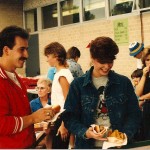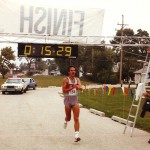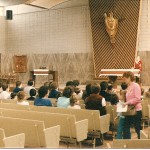1958

Site of Our Lady Of Lourdes from 1958 Aerial Map
Our Lady of Lourdes Congregation was canonically established by Archbishop Albert E. Meyer on June 20, 1958. He chose the name of the parish to recognize the centennial anniversary of the appearance of the Blessed Mother to St. Bernadette at Lourdes. Fr. Charles Kleefisch was appointed pastor the same day. He arrived in Milwaukee after having served as Assistant Pastor at St. Peter’s Church in Beaver Dam from March 1942 to June 1958.
The property on which Our Lady of Lourdes was to be built was a valley, and parts of the property were swampy. Fr. Kleefisch lived at St. Gregory’s parish until August 28, 1958, when he moved into the priest’s house adjoining the church property on 56th St. The first corporation meeting was held on August 6, 1958. Ray Flagge was appointed to the office of Parish Secretary and Dan Schatzman as Parish Treasurer.
Darby-Bogner and Associates was contracted to lay out a general plot plan and to design the first building—a future gymnasium. This explains the off-center main entrance. The gymnasium was to be used temporarily as a church, the future shower and locker rooms as a meeting room (Room 10), and the backstage rooms for a sacristy and business manager’s office. People in the surrounding parishes began to register as members of Our Lady of Lourdes on August 15, 1958. 413 members were registered, representing about 190 families. The members used Lourdes envelopes at Blessed Sacrament, St. Alphonsus, and St. Gregory’s churches and the envelopes were then given to Our Lady of Lourdes.
We worshiped together as a parish family for the first time at the Greenfield City Hall on October 26, 1958. Seventy people attended the 8:00 am Mass, 100 attended the 9:30 am Mass, and 125 people celebrated the 11:00 am Mass. We worshiped together for a total of thirteen months in the City Hall.
In November 1958, the Usher Society and the choir met for the first time. The choir, directed by organist Marge Andritsos, debuted at the 8:45 am Mass on Christmas Day. With the increase in membership, the number of Sunday Masses grew to four. Mass times were 7:30 am, 8:45 am, 10:00 am, and 11:45 am. No Midnight Mass was held in 1958 and no Nativity scene was erected because the City Hall was only used one day a week. The first Christmas collections were used to purchase a new organ for use in the City Hall on Sundays. The organ cost was $1,400. During the first year, parents sent their children to St. Gregory’s or St. Alphonsus for religion classes.
1959
In early 1959 several groups were formed. St. Vincent DePaul met for the first time in January 1959. In February, the first Holy Name and the first Christian Mothers Confraternity and Altar Society (later Christian Women) meetings were held.
The building plans of the “temporary” church were approved by the new Archbishop, William. E. Cousins. On April 26, 1959, the land was blessed by Fr. Kleefisch, and the ground was broken. Excavation began a week later after being held up because of wet weather. Work on the church continued during the rest of the summer. A lengthy truckers’ strike and a very rainy autumn continued to delay the building of the church.

Drawing of the temporary church.
As the parish continued to grow, the number of Masses increased from four to five Masses at 6:30, 7:30, 8:45, 10:15, and 11:40 a.m. Fr. John E. Twomey, a professor at St. Francis Seminary, regularly helped on Sundays. Student priests from Sacred Heart Seminary in Hales Corners also assisted on most Sundays. Finally, on November 29th, the last Mass was said in the City Hall and preparations were underway to worship in our new church.

Fr. Kleefisch breaks ground for the church building April 26,1959.
On December 6, 1959, the then one-year-old Our Lady of Lourdes Congregation, now numbering about three hundred families, met to worship in our own church. Chairs were used for that first Mass but by the fourth Sunday all the pews were in place and a very happy parish family celebrated the feast of Christmas together. Six Sunday Masses were now being said at 6:00 am, 7:15 am, 8:30 am, 10:00 am, 11:15 am, and 12:30 pm.
1960 to 1962
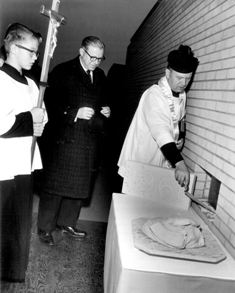
Placing the cornerstone.
In 1960 religious instruction began in our own parish. The first marriage was held in the new church in January 1960, and the first Benediction of the Blessed Sacrament was held in February 1960.
Many of the liturgical items and decorations were donated by parishioners or by different parish organizations. For example, the stations of the cross were donated by members of the parish and were blessed on February 28. On May 1, 1960, Archbishop Cousins came to formally dedicate the temporary church to the service of God. Later in May, 68 children received their first Holy Communion.
By the fall of 1960, the parish had grown to 700 families and it was necessary for the archbishop to appoint an Associate Pastor. Fr. David Wanner was welcomed in September of 1960 and immediately started working with the young people of the parish. Fr. John Twomey also continued as Sunday Associate.
Our parish continued to grow. CCD classes were crowded, and more classrooms were needed. On May 14, 1961, groundbreaking ceremonies were held for an addition to our building. The addition included nine classrooms, a hall, and kitchen facilities. Construction was started on May 28, 1961, and five months later on October 29, the cornerstone of the new classroom addition was laid by Fr. Kleefisch. On May 10, 1962, the school and hall addition were blessed by Archbishop Cousins.
1974 staff planning session: From L-R Sr. Regina Pacis, Deacon Dominic Roscioli, Reggie Schmid, Marge Gawin, Fr. Kleefisch, Mary Cesel, Fr. Joe Juknialis, Jeannie Jarvis, Fr. Jack Van Abel, Mary Worley With the renewal in the Church mandated by the Second Vatican Council, 1968 brought changes to our parish. Notably, the altar was moved so the priest could face the congregation during the Mass. In the spring of 1970, elections were held for the first parish council. John Weidner was elected President. The first meeting was held on April 27, 1970. In September of 1971 at the urging of Fr. Kleefisch (who typed the weekly bulletins himself), Our Lady of Lourdes started its first newspaper, The Lourdes News. John Stok was named the first editor. The early ‘70s also brought about changes in the music ministry. Fr. Kleefisch allowed guitar to be played at the 11:00 am Mass, but it was not allowed in the church. The “guitar mass” had to be held in the hall. A Mass with traditional organ music was held in the church at the same time. Eventually the “guitar mass” in the hall drew more worshipers than the “organ mass” in the church and the guitar was allowed in church. Lourdes was one of the first parishes in the archdiocese to integrate guitar and more contemporary music into the liturgy. By 1973, Our Lady of Lourdes membership had stabilized at about 1,600 families. Judi Bartholomew, a sculptor from our parish, carved a beautiful statue of the “Risen Christ” It was hung in time for the 1973 Easter services and remains today as a focal point in our church. The Christian Women donated the accompanying cross. Along with the changes brought by the formation of the Parish Council, a broader view of the church mission came about, and more parishioners became involved in parish life. In March of 1974, Archbishop Cousins named seven people of our parish as the first Extraordinary Ministers of the Eucharist (now known as Eucharistic Ministers). They were John Champagne, Sam Lupo, Ann Lutschak, Anthony Meleski, John Monday, Sister Regina Pacis Meservey, and John Wolfe. By this time, the Mass schedule was as follows: Saturday 4:00 pm and 6:30 pm, Sunday 7:30 am, 9:30 am, 11:00 am, 12:30 pm, and 6:00 pm. In 1976 Fr. Bill Stanfield asked Marge Berendt to serve coffee and donuts after the new Wednesday morning Mass he was planning for the parish seniors. This started the Faith Group Social, which started with about fifteen members and by the late 1970’s had approximately 250 members.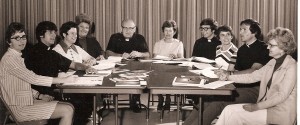
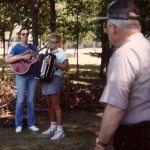

By the early 1980s guitars were commonly used during Mass. CCD classes were changed to a two-week summer program with activities during the fall and winter months. In response to a growing shortage of priests, on July 1, 1981, Our Lady of Lourdes appointed a lay person, Charlene Faiola, as Pastoral Associate. In 1982 the bas relief carving of the Nativity was created for the parish by Judi Bartholomew. 1983 marked Our Lady of Lourdes’ 25th jubilee. During the early years, the foundation was laid for not only our parish but for many of the ministries and groups that continue today. In the 25th Anniversary directory, it was written, “During the years since the Parish Council has been formed, our goal has been to lead the parish from a traditional institutional church to a sharing, caring Christian community.” That mission has continued. During all the changes and growth of the first 25 years of Our Lady of Lourdes, Fr. Kleefisch was a constant presence for the community. In 1983, a pastoral team was formed, with Fr. Charles Schramm joining Lourdes as administrator of the Pastoral Team. Fr. Kleefisch remained as a Pastoral Team Member for three additional years in a transition of leadership. During this period, some parishioners describe the arrangement as having “co-pastors”. In 1983 the Over 50 Group grew out of the Faith Group Social, which met after every Wednesday Mass. Since its inception, the vibrant Over 50 Group has met once a month after the Faith Group Social to provide entertainment, speeches, and special outings and trips for its members and guests. Our Lady of Lourdes has a history of being a welcoming community. Adding to the sense of community was the annual festival, called the Lourdes Fun Fest, which started in 1985. This festival drew hundreds of parish families and guests every August. With the hard work of many volunteers, this important fund raiser was held for more than thirty years. In 2018, the decision was made to discontinue the festival. When Fr. Kleefisch retired in 1986, after 28 years of service to Our Lady of Lourdes, Fr. Michael Strachota joined the pastoral team. Also joining as a pastoral associate was Judy Bialk. Fr. Kleefisch hands over the keys to Our Lady of Lourdes to Fr. Chuck Schramm at his retirement in 1986. During the mid ‘80s, there were several changes to the Lourdes facilities. A new organ was installed in 1986. The two houses that served as living quarters for the priests were sold. Before they were sold, the dining room that joined the two houses was removed to make them more marketable. The brick house that was the priest’s house, which had been donated to the parish and rented out for income, was remodeled into living quarters. The change that may have had the most dramatic liturgical impact was the introduction of the immersion baptismal font in 1988. Both Fr. Schramm and Fr. Strachota were in favor of baptism by immersion—an ancient custom that had begun to make a liturgical resurgence. The new font even made news when Fr. Schramm was interviewed about it in the Milwaukee Sentinel. Through the years, Our Lady of Lourdes gained a reputation for its rich liturgies. By the mid-1980s, Our Lady of Lourdes had a reputation for using newer and more contemporary liturgical music. Many fine liturgy coordinators, pastoral associates, music directors, and volunteers have helped shape our liturgies. Among these was Dan Schutte, S.J., a nationally known composer of religious music, who served as music director from 1987-1991.

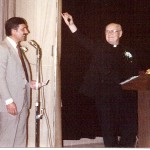
To create a more flexible worship space the church was remodeled in 1991. The pews were removed and replaced with upholstered chairs that could be joined together. The chairs enabled changes to the environment, such as during Lent when chairs were rearranged around a central altar. Fr. Tom Suriano led a group of parishioners on a pilgrimage to theVaticanin 1998. Marian Anderson, a parishioner, is touching Pope John Paul II’s hand. Behind her is Fr. Tom (with the camera). More pastoral change took place in 1992. Fr. Schramm decided to seek another assignment after nine years at Lourdes. When it was announced that Fr. Strachota would be leaving, too, the community was shocked. News of Lourdes’ reaction to the changes even reached the local newspapers. Fr. Strachota had hoped to stay longer, but the Archdiocese had other plans. Fr. Thomas Suriano became pastor. A self-described “recovering scripture professor,” Fr. Suriano broke open the scriptures in a thought-provoking way during his homilies. Another ministry started in 1992—the Youth Drama Ministry which performed its first play, Godspell. The Adult Drama Ministry started several years later in 1995. The groups held twenty-nine performances over the years: sixteen youth plays, eleven adult plays and two joint plays. Karen O’Neil directed most of the plays. Productions included Cotton Patch Gospel, Do Black Patent Leather Shoes Really Reflect Up, Joseph and the Technicolor Dreamcoat, Jesus Christ Superstar, and many others. The ministry ended in 2008 with a joint youth and adult production, Feast of Life, directed by Ryan O’Neil. In the early 90s Chris Deily introduced movement ministry to OLOL when she came from Church of the Gesu parish to work with Dan Schutte. Throughout the years, children, teen girls, and boys as well as adult men and women of all ages have participated in Sacred Movement Ministry. It has been an open opportunity for anyone who wants to experience being a vessel of prayer, worship, and praise during special OLOL liturgies throughout the liturgical seasons and at other special prayer opportunities. (See Sacred Movement Ministry History 1990s-2023) In 1993, the floor that had been installed in 1991 was replaced due to a manufacturing defect. Mass was held in the hall until the work was completed. In 1994 Deacon John Monday, who served Our Lady of Lourdes from 1975-79, returned as permanent deacon. In 1995, Fr. Michael (Mick) Savio became associate pastor. Race concerns were examined in the 1996 multicultural program, Beyond Racism. This program was created to generate dialogue, awareness, and acceptance regarding cultural, racial, and ethnic differences within the greater community.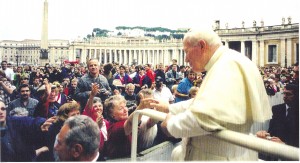
Through the years Our Lady of Lourdes has been involved in various human concerns issues. Hosea, an ecumenical group dealing with social issues was formed in 2003. Starting in 2000, teens from the parish participated in summer Mission Work, helping in Milwaukee and beyond. Our Lady of Lourdes partnered with Norwich Mission House (now Outreach to Haiti) in Port Au Prince, Haiti. Fr. Gerry Kirby from Norwich Mission House visited often, and groups from our parish traveled to Haiti to help. Once a month, parishioners provide and serve food at the St. Ben’s Meal Program. Among the significant events that took place in the new millennium, the first Senior Prom was held for senior members of the parish. This event, facilitated by high school students in the parish, was an annual hit. The Young Adult Ministry formed in 2002 and produced several ongoing programs, including: Mom’s Bible Study, the Family New Year’s Eve Party, the Evening for Couples, and Financial Peace University. A spiritual support group, “Sharing the Healing, Sharing the Hope” was also founded for those affected by mental illness. In December 2002, Fr. Tom Suriano announced to the parish that he was seeking a new assignment when his term as pastor expired the following summer. While saddened by the move, the community was pleased to welcome back a familiar face as former associate pastor Fr. Mick Savio became pastor in July 2003. The decline in the priesthood forced all parishes in the archdiocese to deal with the priest shortage. In 2004 Our Lady of Lourdes began a process of exploring its future with the guidance of consultants from the Parish Evaluation Project, Sr. Peg Bishop and Fr. Thomas Sweetser, S.J. In 2006, religious education took on a whole new focus. Seizing an opportunity to have an intergenerational religious education program, GIFT was formed. Generations In Faith Together was a new way to cover the childhood catechism curriculum while enriching the spiritual lives of adult members of the parish. Outreach to homebound parishioners also continued with programs such as Creative Connections and the Prayer Shawl Ministry.

In 2008, the parish celebrated fifty years and was home to some 1,500 families. In 2009 Fr. Mick Savio moved to St. James Parish in Mukwonago and Father William Burkert became the new pastor. Fr. Bill began the practice of acknowledging birthdays and anniversaries after the announcements at the end of Mass. He served as pastor until 2017. In the summer of 2016, Fr. Bill announced that he would retire the following year. That fall, the process of his leaving began. Fr. Thomas Demse, pastor of St. Gregory the Great, and Fr. Bill began to discuss a proposal to the Archbishop for a Parish Director to be appointed to OLOL. Fr. Tom would serve as the Supervising Priest and Fr. Bill would serve as the Assisting Priest. This arrangement would serve three purposes: Rick Tank, head of Priest Personnel, came to OLOL one late fall evening in 2016 to sit with the Pastoral Council, the Finance Council, and the Pastoral Staff to hear needs and concerns going forward. He was presented with a parish profile and a strong opinion that we should have a lay leader. A few days after this meeting, Rick Tank contacted Nancie Chmielewski to inquire of her interest in becoming Parish Director. She met him for an interview and filled out an application. Over the next six months, she spoke with various acquaintances and friends who were serving in that role in other parishes. She was heartened by their reflections on the ministry and felt more certain that this was her call. In the spring, Fr. Bill and Nancie began to gently suggest/prepare the parish for such a change, even though there was no definitive decision from the Archdiocese. They did, however, want to make this potential change of leadership model as smooth as possible. The final Friday of April, Nancie received her appointment letter, and the decision was announced to the parish. Transition plans were put into place and the third Sunday of June 2017, we celebrated Fr. Bill’s pastorate and new position as Assisting Priest, and Nancie’s appointment as Parish Director/pastor. The first year of Nancie’s pastorate involved a great deal of learning. There was no manual or mentorship in place for this role. Fr. Bill and Nancie worked together, and he was an excellent coach. One of the things he did to help the parish to accept the new leadership was to always point to Nancie as “his boss.” While he did this with gentle humor, it was true, and helped folks to embrace the new model. One of the strengths of Nancie’s appointment is that she had already been serving the parish in various ministerial areas for 11 years. She knew folks and they knew and trusted her. Helping people to understand that she was the pastor required some creativity. At weekend liturgies, Nancie took on the roles of greeting the community in church before Mass began; proclaiming the Petitions, distributing Eucharist, and announcing what she liked to call the Discipleship Opportunities for the week. After about a year, she also processed in and out with the presider, and led the bow, remaining in the sanctuary. She assisted in Baptisms and played a leading role in First Eucharist and eventually, in First Reconciliation. In June of 2022, Nancie announced that she would retire in 2023. Again, the Pastoral Council, the Finance Council and the Pastoral Staff met with the Manager of Priest and Lay Ecclesial Personnel and Placement, Brenda Cline. A Parish Profile was prepared and presented to her noting that the parish had been thriving under the Parish Director leadership model. In spring of 2023 Deb Steppe was appointed as the next Parish Director. Deb had been serving in the role of Director of Liturgical Ministries. That summer the parish celebrated Nancie’s years of service and leadership and welcomed Deb as our new leader. The community continues to be grateful for the service of our Parish Directors. Over the years other parish staff have joined and left us. Judy Bialk retired in 2013. In 2020 after many years of service, Chris Deily retired as Director of Liturgy, and Deacon John Monday retired. Others who served included Sister Joanne Meyer, Rick Cesar, Mary Osep, Anne Gloudeman, Jenni Sladky, Joe Kallenberger, Peg Kasun, Sister Edie Crews, and Taylor Baar. After Father Bill Burkert became Assisting Priest in 2017, several senior diocesan priests began helping more regularly with liturgies. Some were familiar faces, and some were new faces. Former pastors, Fr. Chuck Schramm, Fr. Tom Suriano and Fr. Bill Burkert joined us regularly. Others included Fr. Dave Cooper, Fr. Peter Drenzek, Fr. Alan Jurkus, Fr. Bill Kohler, Fr. Dennis Lewis, Fr. John Lukaszewicz, Fr. Mike Marco S.J., and Fr. Domenic Roscioli. In 2012 the church was reconfigured and redecorated. The altar was moved permanently from the east side to the center of the north side of the space. In previous years, the altar was temporarily moved to this position for the season of Lent. Audiovisual equipment was installed. The first use was for slideshows of the departed which could be displayed on screens before funerals. The Eucharistic Prayer and baptisms could be highlighted with video so everyone could see. A significant challenge that began in spring 2020 was the COVID-19 pandemic. The church was closed starting the weekend of March 14-15, 2020, a few days before the State of Wisconsin mandated closings on March 17. The pandemic was a time of great stress, but also, of tremendous creativity for our community. With our very talented staff, we kept the lines of care and communication open, and developed a way of doing liturgy online. The first Masses were recorded at Fr. Bill’s home. Lectors recorded readings and sent them to Deb Steppe. Musicians recorded at home and their recordings were compiled by a parishioner using a music software program. The final recording was posted on YouTube. Later Masses were recorded in church with only the readers, musicians, and ministers present. For Easter Sunday, April 12, 2020, staff members created videos in their homes for the Triduum; there were no in-person Holy Week or Easter liturgies. Usually for Pentecost, everyone wears red to church. That year, everyone submitted photos of themselves wearing red and that video was at the beginning of the Pentecost Mass video. Nancie Chmielewski began recording weekly video “Wednesday Table Reflections” so that people could have some type of prayerful, weekly connection outside of Sunday Liturgy. The weekend of July 4-5, 2020, the church was reopened for in-person Masses. People registered in advance to attend, wore masks, and attendance was logged in case follow-up contact tracing needed to be done. Socially distanced seating was marked with painter’s tape on the chairs, doors were locked during Mass, and announcements and music were posted on screens before and during Mass. After each Mass chairs were sanitized. The pandemic offered us chances to connect with people in a new way. Funerals and weddings were difficult as the number of people who could attend was limited. Committees and other groups learned how to use Zoom videoconferencing. Virtual and eventually hybrid meetings allowed for greater participation and provided ministry beyond our walls and even beyond city and state lines. Nancie reported that “once we could bring folks back, I felt like a country parson, greeting each person at the door.” Eventually masks became optional, Nancie stopped spritzing people with hand sanitizer as she greeted them at the door, and finally by August 2022, an in-person “Bring All of You” Welcome Back event was held with a hotdog picnic and a Ministry Fair. The Saturday 5:00 p.m. Mass continues to be available for livestreaming or playback on YouTube for those who cannot attend. Generations in Faith (GIFT), the intergenerational faith formation program, and the Rite of Christian Initiation for Adults (RCIA) continue as primary formation processes. In 2014 the Discipleship Institute was created. It began with a question asked by the adults in the RCIA process: “Where do we go from here?” RCIA leads these budding Christians to ask questions and to go in search of the answers, in short to learn more about their faith. Harry Fledderman and Anita Hallman Kowalski were facilitators within RCIA and they discussed possibilities for these folks. They encouraged the RCIA adults to take part in the GIFT program, but it seemed that more was needed. At that time, Harry was involved in teaching in El Paso in the summer at an institute for catechists. They started wondering how to get something started like that at Lourdes. Since then, the Discipleship Institute has flourished and grown. (See Discipleship Institute History 2014-2023). Parish Ambassadors began in September 2017 with twelve people who came together over their common love of our parish and all it has to offer. As a disciple, the Parish Ambassador is a representative of the welcoming community we are. Ambassadors smile and say hello to all those they meet, engage people with conversation or small talk, listen to the needs of the person and address those needs, reach out to the visitor or new member to make them feel welcome and comfortable, and are knowledgeable of parish events and the facilities. They are the “face” of OLOL beyond our walls by extending that hospitable presence everywhere they go. By 2023 the number of Parish Ambassadors had almost doubled and continues to increase until all parish members know that they are Parish Ambassadors. Gay & Straight in Christ began in September 2013 and welcomes, supports, and affirms LGBTQ+ (lesbian, gay, bisexual, transgender and queer) persons, their families, friends, and those who wish to stand in solidarity with them in Christ. GASIC strives to provide the message that our community is open to all persons as a welcoming Christian community. Lourdes is on the National Registry of LGBTQ+ friendly parishes. Because of this, many people found us during the pandemic, and because of this the group continues to meet virtually to accommodate those joining each month from all over the country. The Art Guild was started under Mary Ann Logic’s initiative in 2011. The first Hallway Art Gallery Exhibition was held in 2011. The Community Art Mosaic project began in 2015-16. Events were not held in 2020 and 2021 due to the Covid pandemic but resumed in 2022. Throughout the years a strong core membership has helped the community look at spirituality through art. In 2018 the large grassy area on the north side of the property became a Community Garden managed by UW Extension. With the efforts of Dennis Lukaszewski and Brad Julga, Our Common Home Community Garden was launched to become a neighborhood hub that emphasizes the community in community gardening. Over the years, youth groups flourished under the direction of Mary Osep, Taylor Baar, and Maggie Russell. The annual women’s retreat was started in 2008 by Nancie Chmielewski and Claudia Porter. Deb Steppe joined the team in 2011. From 2008 to 2020 the retreats were held at Benet Lake Retreat Center. Retreats were not held in 2021 and 2022 due to the Covid pandemic. They resumed in 2023 at the Sienna Center in Racine. The well-attended retreats are open to all women with a new theme each year. The first Oktoberfest Artisan Fair was held in the fall of 2010. Oktoberfest has five goals: to build community at OLOL, to introduce OLOL to the larger local community, to celebrate art and talent, to support the social justice issue of buying local from small businesses, and to raise funds for the parish. Like the parish festival in previous years, Oktoberfest relies on the work of many dedicated volunteers. The Faith Social Group, which started in 1976 and grew into the Over 50 Group in 1983 continues to meet as the Wednesday Morning Faith Group. Alverno Nursing students began offering educational and nurse consultation services in fall 2020 when the parish nurse from Aurora Advocate died. Students came to the parish 10-12 times during the semester working primarily with the Wednesday Morning Group. They also participated in special events such as the Bring All of You Welcome Back picnic, Spring Cleaning and Oktoberfest. The Lazarus Bereavement Committee has been active since at least 2012. The committee’s volunteers minister to families grieving a loss with prayers, cards, and an annual All Soul’s Day prayer service. A support group for adults experiencing grief, “Walking Through Grief Together” was started about 2021. Ministry to the homebound, the prayer ministry, and the prayer shawl ministry continue to be active. The various Social Services ministries are all long-standing in the parish. St. Vincent de Paul Society has been serving since 1959. The Lourdes Food Pantry has been active since at least the 1990’s; Leonard Schultz and Sharon Piotrowski have been long-time coordinators. Originally the group packed food bags for people in need on scheduled food pantry days and packed for holidays. Later recipients started coming directly into the pantry. Outreach to Haiti and the St. Ben’s Meal Program have continued to be active since the early 2000’s. The Social Justice committee first met in 2007 and is committed to improving the lives of the less fortunate. Over the years the committee has encouraged voting and provided sample ballots for elections; sponsored events on a variety of topics such as human trafficking, racism, immigration, and diversity; initiated recycling programs; and collaborated with the Discipleship Institute and other parishes to educate themselves and all Lourdes parishioners. The Social teachings of the Church, which are displayed on a wall in the parish hall, guide their choices and actions. Together they explore links between faith and life, and theology and ethics. After the pandemic and before her retirement as Parish Director, Nancie Chmielewski initiated a visioning process for the parish starting in 2021. She and Rebecca Porter led a process that engaged the entire community. This led to a strategic plan based on our values—all are welcome to come as they are and to serve. The plan created a vision for the future—to grow joyfully together grounded in who we are, whose we are and how we are to serve in the world. With the rich history of Lourdes’ past, and with a strong, dedicated community and leadership, we are moving confidently into the future. As Deb Steppe wrote in the introduction to the 2023 Parish Guidebook, “We strive to be a parish that prays well, welcomes everyone, and serves God’s people near and far. Parish Staff
A Parish Director—2017-2023
Parish Facilities
The COVID Pandemic
Faith Formation
Discipleship Institute
Parish Ambassadors
Gay and Straight in Christ (GASIC)
The Art Guild
Our Common Home Community Garden
Additional Formation Ministries
Youth Groups
Women’s Retreats
Community Life
Oktoberfest Artisan Fair
Wednesday Morning Faith Group
Outreach Ministries
Pastoral Ministry
Social Services
Social Justice
Moving into the Future






